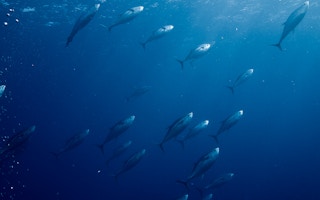Policy debates about the growing body of evidence showing that our oceans are on the decline tend to overlook one important detail: Ailing seas hurt the economies of all nations—large and small, landlocked and maritime. That makes it vital that political and business leaders around the world recognize this threat to the global economy and act to restore our seas to good health.
The oceans cover more than two-thirds of the Earth’s surface. They provide food and a source of income to billions of people, supply oxygen for every other breath we take, and absorb nearly half of the world’s carbon emissions. Even a partial loss of these benefits would threaten human health and well-being, and have significant negative economic consequences around the world.
If that sounds alarmist, consider how much we rely on healthy marine ecosystems and their abundant fish populations. Globally about 1 billion people rely on fish as their main source of animal protein, and about 200 million work in the fishing sector. Fish and fish products are among the world’s most traded food commodities, totaling nearly $130 billion in annual exports.
When secondary economic activities associated with fisheries, such as international transport and boat construction, are taken into account, the value of fisheries to the global economy grows to almost $300 billion. In Europe alone, the European Commission reports, coastal and marine tourism generates about $210 billion and creates about 3.2 million jobs.
Yet fish populations are in trouble. For example, driven by over a century of overfishing, Pacific bluefin tuna are down more than 97 percent from their highest levels. But overfishing is not the only threat to the health of the oceans.
Fishing gear such as bottom trawling, in which boats drag heavy nets across the seafloor, can easily destroy ancient corals and other habitat. Warming waters are causing sea level rise, coastal flooding, and more intense and frequent storms. And as oceans become more acidic and polluted—including an epidemic of discarded plastic—the degradation of the oceans grows worse.
An estimated 5 million to 13 million tons of plastic enter the ocean every year. The potential toxicity of plastics and their effect on the health of marine organisms and people who consume seafood is now a serious concern. In addition to the ecological and environment costs, marine plastic pollution is causing at least $13 billion annually in economic losses.
And the local costs of cleanup run into the tens of million a year. These estimates do not yet include the potential costs to human health.
While scientists and conservationists have been working for decades to save the oceans, these efforts have justifiably focused on reducing damage to marine ecosystems and fish populations. But the time has come to view ocean health through the much wider lens of a “blue economy,” in which the sustainable use of ocean resources is recognized as critical to global economic growth and wellbeing.
“
It’s a false choice to suggest that we can’t have both healthy seas and a robust global economy. In fact, saving our oceans is the best way to ensure that we have both.
The issue of how to govern our oceans sustainably while boosting the global economy was at the top of the agenda at the recent World Ocean Summit in Mexico, where world leaders, government ministers, businesses, and environmental experts convened. In their discussions, they considered steps to integrate actions that promote ocean health into their economic development strategies.
Collectively we need to crack down on illegal fishing, which cheats law-abiding fleets and governments out of revenue, robs coastal communities of jobs and food, and often destroys sensitive habitats. Illegal, unreported, and unregulated fishing accounts for up to $23.5 billion worth of seafood a year.
Leaders worldwide should also push for an end to fisheries subsidies. These government payments—of at least $20 billion a year—go mainly to industrial fleets and not to small-scale fishers, making it artificially cheap to fish, enabling vessels to stay out longer and stressing fish populations beyond what is sustainable.
It’s also important to invest in protecting marine habitat for the benefit of tourism and fisheries—in particular, coastal wetlands, mangroves, salt marshes and sea-grass beds. Coastal wetlands are essential fisheries nursery areas, sequester vast amounts of carbon dioxide, and mitigate the impacts to coastal communities of sea level rise, severe storms, and tsunamis.
Their restoration and protection would save billions of dollars in insurance payouts and reconstruction costs as storms become more frequent and more severe.
Our oceans are under severe pressure. And it’s a false choice to suggest that we can’t have both healthy seas and a robust global economy. In fact, saving our oceans is the best way to ensure that we have both. Now is the time to protect our marine environment—and to hand future generations a stable, productive, and economically viable planet.
Tom Dillon leads The Pew Charitable Trusts’ international conservation work. This article was written exclusively for Eco-Business.


















